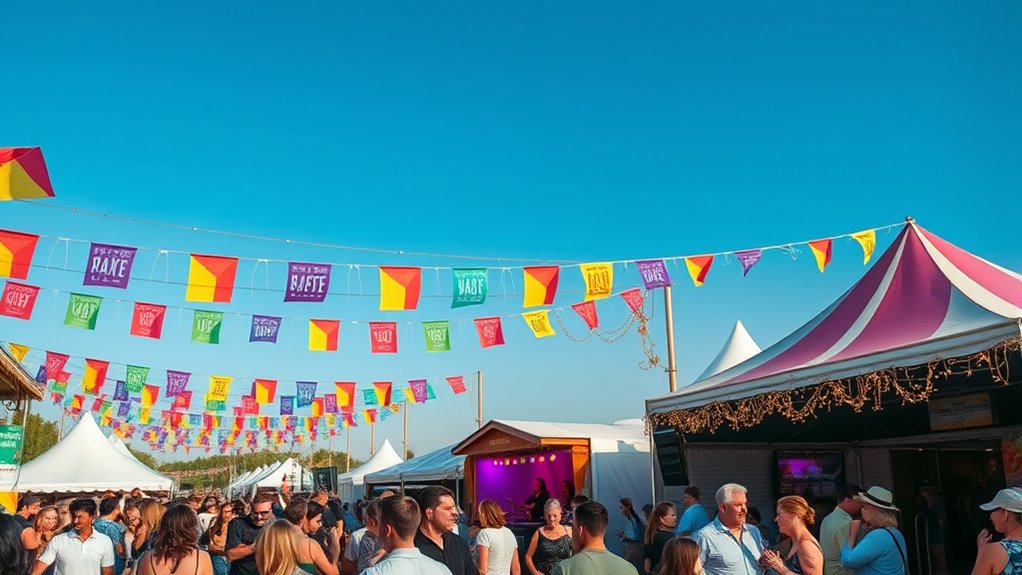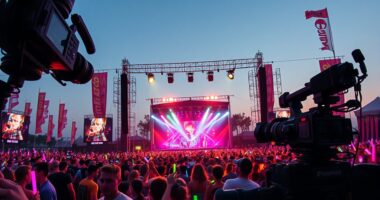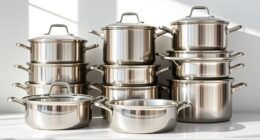To build a shot list for a one-day festival shoot, start by researching the event schedule and layout. List must-have shots like performers, crowd reactions, and key decor, leaving room for spontaneous moments. Plan wide shots, close-ups, and candid images, while considering crowd flow and vantage points. Pack the right gear and stay flexible to adapt as the event unfolds. If you keep exploring, you’ll discover how to optimize your shots and capture the festival’s vibe perfectly.
Key Takeaways
- Research the festival schedule and layout to identify must-have shots and key moments to prioritize.
- Start with wide establishing shots and incorporate close-ups, candid moments, and spontaneous scenes for storytelling.
- Observe crowd flow and dynamics to position yourself strategically without disrupting attendees.
- Prepare an equipment checklist with versatile lenses, extra batteries, memory cards, and stabilization gear.
- Schedule shots around event timing, remaining flexible to adapt to spontaneous opportunities and changing conditions.

Ever wondered how to capture the essence of a festival in a single day? It’s all about planning your shot list carefully, understanding crowd dynamics, and being prepared with the right equipment checklist. A well-structured shot list helps you maximize your time, guarantees you don’t miss key moments, and allows you to adapt to the unpredictable flow of festival crowds. Before the event, research the festival’s schedule and layout. Map out the must-have shots — from performers and decor to candid moments among attendees. Keep in mind that festival crowds are constantly shifting; some areas will be packed while others are more relaxed. Recognizing these crowd dynamics helps you position yourself for the best shots without causing disruption or missing spontaneous interactions.
Start your shot list with wide establishing shots that depict the overall atmosphere — the stage, banners, and the general buzz of the crowd. These set the scene and are essential for storytelling. Next, plan closer shots of performers, vendors, and key festival elements. It’s vital to include candid shots of attendees enjoying themselves, as these capture emotion and authenticity. Remember, festivals are lively, unpredictable environments, so be flexible. Some moments will happen spontaneously, and your shot list should leave room for those surprises.
Begin with wide shots of the festival scene, then focus on performers, vendors, and candid attendee moments.
To stay efficient, create an equipment checklist tailored to the event. Your list should include essentials like multiple camera batteries, memory cards, lenses suited for wide and close-up shots, and possibly a monopod or stabilizer. Don’t forget accessories like lens cleaning kits, portable lights, and backup gear. A thorough equipment checklist ensures you’re ready for any situation and reduces the risk of missing important shots due to technical issues.
As you develop your shot list, consider the flow of the day. Some moments happen early, like setting up or pre-show ambiance, while others—like main acts or crowd reactions—occur later. Timing your shots helps you allocate your energy and gear accordingly. Also, think about vantage points—elevated positions for crowd shots, ground level for intimacy, and different angles for variety. This diversity enriches your coverage and keeps your story dynamic.
Additionally, understanding the importance of market research can help you anticipate the types of moments and scenes that will resonate most with your audience, allowing you to focus your efforts more effectively. Finally, prepare to adapt. Festivals are lively and unpredictable. Having a detailed shot list, understanding crowd dynamics, and a complete equipment checklist will give you the foundation to capture the event’s energy accurately. With this preparation, you’ll be ready to seize fleeting moments and craft a compelling visual story of the festival day.
Frequently Asked Questions
How Do I Prioritize Shots Under Limited Time Constraints?
To prioritize shots under limited time, focus on shot list organization by identifying must-have scenes first. Use time management strategies like setting time limits for each shot and grouping similar shots together to save time. Be flexible, and don’t hesitate to skip less critical shots if needed. Keep communication clear with your team, so everyone stays on track and knows which shots take precedence, ensuring you capture the essentials efficiently.
What Equipment Is Essential for a Festival Shoot?
Did you know that 85% of festival footage relies heavily on just a few essential gear? For your shoot, prioritize a reliable camera gear setup with a versatile lens, extra batteries, and memory cards. Don’t forget a portable lighting setup for low-light scenes and a sturdy tripod for steady shots. These essentials ensure you capture high-quality footage quickly and efficiently, even under tight time constraints.
How Can I Ensure Variety in My Shot List?
To guarantee variety in your shot list, incorporate different lighting techniques to create diverse moods and atmospheres. Plan shots at various angles, distances, and perspectives to add visual interest. Think about how color grading can enhance the mood and highlight different scenes. By mixing close-ups, wide shots, and candid moments, you’ll capture a dynamic range that keeps your festival coverage engaging and visually compelling.
What Contingency Plans Should I Prepare for Weather Issues?
If rain threatens your shoot, you should prepare rain preparations like waterproof covers for your equipment and plan shelter strategies, such as tents or nearby structures. For example, during a music festival, crew quickly set up portable tents to protect gear and shot areas. Always have backup plans, including alternative indoor locations or flexible shot schedules, to keep filming smoothly regardless of weather changes.
How Do I Coordinate With Festival Staff and Performers?
You should coordinate with festival staff early, establishing clear communication channels. Arrange backstage access for smooth guest interactions and shot opportunities. Confirm schedules, set expectations, and share your shot list to guarantee everyone’s on the same page. Keep a contact list handy for quick updates and be flexible to adapt as the day unfolds. Building rapport with staff and performers helps you capture authentic moments without disruptions.
Conclusion
By planning your shot list carefully, you guarantee you capture the festival’s energy and diversity efficiently. Remember, while it’s tempting to include every moment, prioritizing key performances and candid interactions keeps your footage focused and impactful. With a strategic approach, you’ll avoid feeling overwhelmed and create a compelling story that truly embodies the festival’s spirit—demonstrating that thoughtful planning elevates even a single-day shoot to professional standards.









